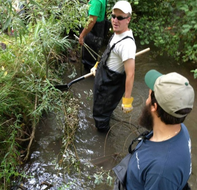|
Along the length of the upper Twelve, we are working with our partners and landowners to enhance the watershed. Our volunteers have worked alongside NPCA personnel to combat erosion, improve stream flow, and provide fish and animal habitat by building lunkers and fascines at critical points in the upper reaches of the Twelve. Removal of perched culverts that are barriers to fish movement, and the creation of spawning beds are among our current projects. The co-operation of landowners is critical to these endeavours.
|
|
The Niagara Chapter has engaged students in Niagara College's Environmental Restoration Program and Geographic Information Systems Program to map and analyze sections of Twelve Mile Creek. The Chapter acts as client to the students who take part in a real world exercise that simulates exactly the work they will do upon graduation. The resulting reports are thorough, professional analyses of the subject reaches of the watershed, and provide the Chapter with a blueprint for improvements that will occupy our efforts into the future.
|
|
Our partnership with the Niagara Restoration Council has produced a series of grants totaling almost $250,000 to improve, restore, and preserve the headwaters. Using the expertise of the Niagara College students under the guidance of Professor Ian Smith (a member of Niagara TUC), we have identified areas of concern and are using various methods of remediation, including planting of native species, creation of stream deflectors, building fascines, and clearing blockages where appropriate. The co-operation of landowners along the Twelve has been vital to our efforts to expand the range and viability of the small Brook Trout population in the headwaters, and we are seeking to establish close working relationships with as many of those who own land along sections of the stream as possible.
|



